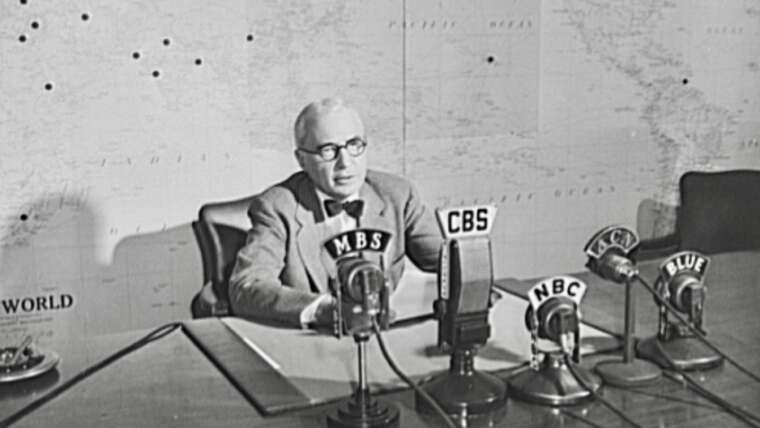Cold War Radio Museum In 1983, Gene Pell, former Moscow correspondent for NBC News, was Voice of America’s (VOA) Deputy Associate Director for Broadcasting (Programs) under VOA Director Kenneth Y. Tomlinson. Gene Pell, had joined VOA as director of news and current affairs in 1982. He later served as VOA Director from June 1985 to October 1985 before taking the…
Cold War Radio Museum After leaving the White House in 1961, former President Dwight D Eisenhower briefly alluded in his memoirs Waging Peace (1965) to the Voice of America’s (VOA) wartime record of propaganda collusion with Soviet Russia. As a military leader during World War II, he must have been still upset to have mentioned it years later during the…

Cold War Radio Museum Elmer Davis, Director, Office of War Information (OWI), Alfred T. Palmer, photographer. Part of: Farm Security Administration – Office of War Information Photograph Collection, Library of Congress Prints and Photographs Division, Washington, D.C. 20540. Soviet Russia’s lie that Hitler and Nazi Germans and not Stalin and Soviets communists were responsible for the mass execution murder of…
First VOA Director was a pro-Soviet communist sympathizer, State Dept. warned FDR White House
Cold War Radio Museum April 1943 – State Department Warns White House of Soviet Influence at Voice of America May 4, 2018 Analysis by Ted Lipien for Cold War Radio Museum In 2018, the online Cold War Radio Museum presented for the first time to a broader online audience a secret 1943 memorandum sent to the Roosevelt White House by the U.S.…
Cold War Radio Museum February 8, 2018 In 1959, the Voice of America (VOA) had a clear and convincing public relations message to describe its mission and to justify its $20 million budget [ref]The Budget of the United States Government for the Fiscal Year Ending June 30, 1959. The United States Government Printing Office, Washington, 1959. Accessed February 8, 2018…
April 20, 1943 — Congressman Woodruff warns of Soviet propaganda in Voice of America broadcasts
Cold War Radio Museum On April 13, 1943, Nazi Germany’s propaganda machine announced the discovery of the graves containing the bodies of thousands of Polish prisoners of war in Soviet captivity who went missing in Russia in the spring of 1940. A few days later, on April 16 and April 17, 1943, the management of the U.S. Office of War…
Cold War Radio Museum Declassified documents in the National Archives show that a directive issued to on April 17, 1943 by the management of the U.S. Office of War Information (OWI) ordered its Overseas Branch in charge of what were later called Voice of America (VOA) radio broadcasts to air and promote the Soviet propaganda denial of Soviet responsibility for…
Cold War Radio Museum Fascinating and until now generally unknown details of how a single refugee journalist, Julius Epstein, exposed Voice of America’s (VOA) censorship designed to cover up Soviet responsibility for the 1940 Katyn Forest massacre of nearly 22,000 Polish POW officers and intellectual leaders can be found in several volumes of the Congressional Record from the early 1950s…
Cold War Radio Museum Ted Lipien Polish socialist and communist activist and journalist Stefan Arski, aka Artur Salman, was among several communist agents of influence who had worked on Voice of America (VOA) radio programs during World War II while employed by the U.S. government Office of War Information (OWI). Arski and several of his Voice of America colleagues on…
The World War II propaganda arm of the United States government, the Office of War Information (OWI), was the parent agency of the Voice of America (VOA). VOA was celebrating its 75th anniversary in February 2017. In this new historical series about the Voice of America, Cold War Radio Museum presents formerly classified U.S. government documents relating to the origins…
OPINION Cold War Radio Museum How Voice of America Censored Solzhenitsyn Brief History of VOA’s Domestic Propaganda By Ted Lipien The Voice of America (VOA) was an easier target than Radio Free Europe (RFE) or Radio Liberty (RL) for U.S. government bureaucrats wanting to restrict human rights broadcasting to the Soviet Union in 1974 as part of the…
Cold War Radio Museum During the Reagan Administration, foreign language services at the Voice of America (VOA) were for the first time given in the 1980s significant freedom to originate their own news reports and to share them with VOA English programs. Some of these news reports and news backgrounders with audio actualities were also shared in English through the…
Cold War Radio Museum Could a foreign power such as Russia try to infiltrate the Voice of America (VOA) or influence its executives, broadcasters and programs? Could U.S. government-hired journalists and program contributors, acting on their own, support in VOA broadcasts accommodation with authoritarian rulers in countries such as China, Cuba, Iran or even North Korea? Could one-sided propaganda produced…
Executive Order 9182 Establishing the Office of War Information June 13, 1942 In recognition of the right of the American people and of all other peoples opposing the Axis aggressors to be truthfully informed about the common war effort, and by virtue of the authority vested in me by the Constitution, by the First War Powers Act, 1941, and as…
Cold War Radio Museum The Crusade for Freedom was the name of an advertising campaign designed to get Americans to contribute money to Radio Free Europe which broadcast radio programs in various languages to the captive nations behind the Iron Curtain during the Cold War. The ad seen here is from 1966 and appeared in an American magazine. This particular…